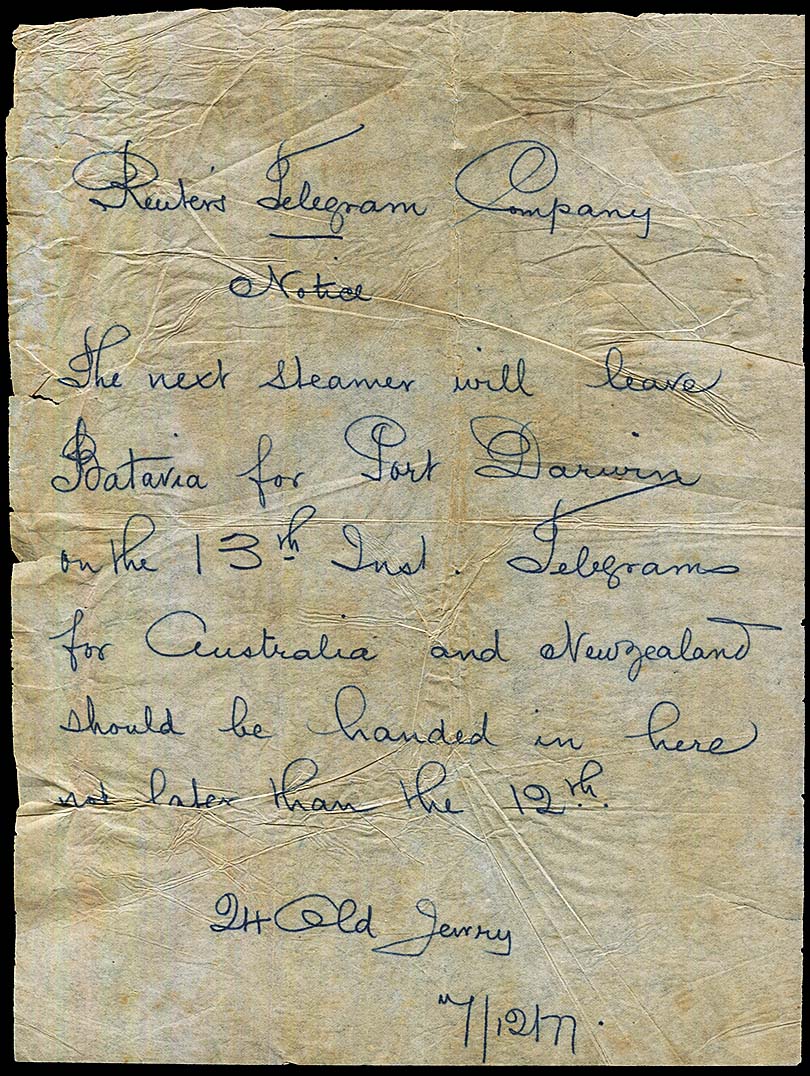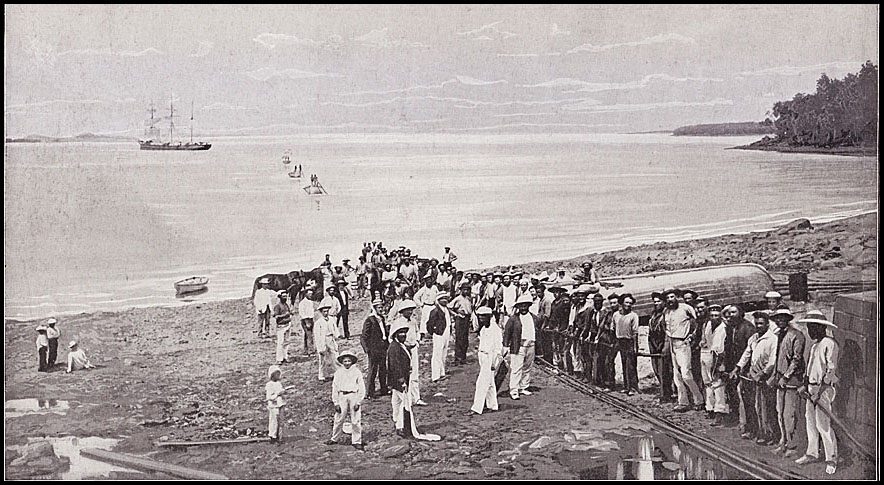The Overland Telegraph Line - Cables from Java to Port Darwin.
- Australia 1901-1988
- New South Wales
- Overview of NSW
- Telegraph lines
- Telegraph Offices
- Date stamps
- Forms
- Envelopes
- Instructional annotation
- Collect
- Delayed
- Free
- Immediate Urgent
- Reply paid
- Rates
- Stamps
- 1871 Telegraph stamps
- 1885 proposal
- 1893 proposal
- Queensland
- South Australia
- Tasmania
- Victoria
- Western Australia
- International
- Special aspects
The Darwin to Java cable is described as follows:
- general ideas as to the landing points and route;
- laying the cable at Port Darwin;
- laying the cable to Banjoewangi;
- the major interruption.
- Need for a second cable.
1. Landing points and the route.
In the late 1860s, it was an almost accepted fact that a cable from Singapore would land somewhere on Java or nearby and then be laid to Queensland. Indeed the Queensland Government had constructed a line from the east coast at Cardwell to Normanton on the Gulf of Carpentaria.
An alternative to a direct cable to Queensland was a shorter cable to Port Darwin and then down to the Roper River or beyond to link with a land line from Normanton or Burketown. The difficulty with that suggestion was that the British Australian Telegraph Company would not now pay for the land-line to Queensland and South Australia was not happy about Queensland constructing a line across its Northern Territory.
The developments of these ideas are of great interest and some of the original correspondence is included as part 1 and part 2 elsewhere. Fascinating reading of great historical significance. A "must read" collection.
2. Laying the Darwin end of the cable.
On 26 October 1871, a number of ships dropped anchor in Port Darwin. Their arrival was a surprise although not unexpected. They had been chartered by the British-Australian Company. The vessels were:
- the C.S Hibernia - a very large ship and she was carrying the coiled 1082 nm long cable to link Darwin to Banjoewangi as well as the Commander of the expedition Captain Robert Halpin;
- the S. S. Edinburgh which was a storeship and collier;
- the passenger-steamer Investigator of 600 tons with a number of technical personnel.
One of the engineers (Stephenson) soon selected a site for the shore station at Port Darwin and a hut was quickly erected. Essential but basic telegraph equipment was then installed. The next task was to construct quarters for the telegraphists and the BAT superintendent of the land-based operation Mr. Enston Squier. The locals of the Colonial administration were put to shame - the BAT personnel had everything possible including a piano, an extensive library and a billiard table.
|
Patterson was informed that, after the land connection was made, the task of paying the cable would take 10 days - certainly less than a fortnight. Not good news for someone in charge of a project which was so far behind schedule.
3. Laying the cable to Banjoewangi.
On Tuesday 7 November 1871, the BAT staff were mobilised. The Hibernia was moored about 1.5 miles from the beach. Three boats were placed between the Hibernia and the beach - each with a wooden bight to hold the cable up as it was brought to the shore. A trench was also dug from the low-water mark to the telegraphists hut.
|
A light line was first run from the Hibernia across the boats. This line was hauled in with the heavy cable attached to the end. All the time, a chant was called to coordinate the pulling. Finally the cable reached the hut and the connection was made and tested from the Hibernia. Naturally "a tot of grog" was then served to all involved. The cable was freed from the bights on the three small boats and all was in readiness to begin sailing.
The Hibernia left immediately, followed by the other two ships, and by night fall, the fleet was out of sight from the land. On 20 November, 1871 the Hibernia dropped anchor at Banjoewangi and the cable was joined to the shore end.
That connection placed Australia in contact with England. Messages were immediately sent by Mr. Squier to the head of the BAT in England. In his message, he commented that the overland wire was far from complete and that he did not think there was any chance of it being completed by the due date of 31 December. The cable could now be used for telegrams sent from Port Darwin and progressively to the south.
On 24 June 1872, the Port Darwin station reported the news that the cable had gone dead. It remained inoperative while Todd's men worked to complete the overland sections. On 18 October the news arrived that, after months of grappling the cable, the fault had been located. The service was restored on 21 October and, as Todd announced "The Australian Colonies were connected with the grand electric chain which unites all the nations of the earth".
In October 1874, discussions were held between the Governments of Queensland, New South Wales and New Zealand "for the purpose of making the necessary preliminary arrangements for constructing the proposed Queensland-Singapore and New South Wales-New Zealand cables, provided for by the respective Governments in 1873-74" (1874 Annual Report for Queensland by the Superintendent, p. 4).
On 27 June 1876, the Evening News published correspondence, at variance with the strategy described above, in the form of a telegram related to a second cable:
"dated 28th June, 1876 from Sir Henry Ayers, of Adelaide to the Hon. Colonial Secretary of New South Wales, Sydney:
Letter of this day in reply to your despatches of eighteenth ultimo and second instant on subject of second cable, is to the following effect:
We think proposals, numbered one and two inadmissible as unnecessary costly, involving large subsidies or prohibitive rates.
We agree with you that the duplicate cable from Port Darwin, as per proposals numbered three and four, would afford the readiest and cheapest means of securing the end desired as the Eastern Extension Telegraph Company have their officers and appliances on the spot and could more readily perform the work than any other company not so situated.
If the line be taken through Java, the company must secure an independent wire to be worked by English operators.
We are clearly of opinion that, under any circumstances, we ought not to be called upon to contribute towards the subsidy as our annual loss is at present £37,000.
On the land line, we agree with the suggestion of constructing a line from Wilcannia as more surely securing certainty of communication than one from Nonnanton.It will be necessary to impose a condition requiring repairing steamer to be always stationed at Port Darwin".
The Sydney Morning Herald of 5 August 1876 carried an article showing a broader perspective for the second cable:
"THE DUPLICATE CABLE.
Since the return of Captain Audley Coote to Melbourne (the Argus says), he has had an interview with the Postmaster-General with reference to the proposals for duplicate cable communication with Europe. He points out that the direct route from Western Australia to Galle will not be so suitable as he anticipated when including that among the proposed routes he submitted as he has now ascertained that the Keeling or Cocos Islands, which lie in that route and which were thought to form an excellent half-way station, would not be suited for that purpose. The islands rise sheer from the sea, the depth of water being so great around them that it is believed no good landing place for the cable could be obtained.
Captain Coote has submitted an amended proposal showing an alteration of the route. He proposes that the cable should start as before from the North-west Cape and run to the Straits of Sunda, touching at the extreme point of the island of Java, and then from thence going direct to Galle. The distance would be somewhat longer and the expense would also be rather above that previously estimated for the other route.
It is not probable that any steps will be taken towards holding a conference between the colonies interested in this subject until after the return of Mr. Cracknell, the Superintendent of Telegraphs in New South Wales".
The necessity for the second cable was continually emphasised by the repetitive breakages especially between Port Darwin and Batavia and beyond to Singapore. The Evening News (Sydney) reported on 27 October 1877, with special reference to the then current break:
"The telegraphic communication with Europe has been most unsatisfactory of late. No sooner has one breakage been repaired than another has taken place in some other part of the line. In many respects, we had better be without a cable at all than have only a single imperfect one.
The interference with business arrangements has been most serious. Firms relying upon a message have just missed the market and incurred very heavy losses. Business with London becomes a sort of lottery, where everything depends upon the chance arrival of a message, which may arrive in a few hours, or a few days or it may be a week or two. For the ordinary items of news, we can afford to wait. The final results of the French elections, the ultimate fate of the Penge murderers, or even the progress of the war, in its present stage, would do one day as well as another, but with Europe in the excitable state in which it has been for some years, events take place with such rapidity that we might be ignorant of circumstances of the utmost political and commercial importance.
Our correspondent informed us that a gentleman left by the Cuzeo prepared to arrange for the duplication of the cable. We sincerely hope that whatever administration is installed in power by the present elections, it will unite with the other Australian Governments in vigorously pushing forward this most desirable undertaking".
The Sydney Morning Herald of 15 November 1877 expanded the discussion about a second cable significantly. The article also addressed the existential problems being faced given the major break which started about the begining of November. The article points out that, with communications so badly interrupted, the South Australian Government intended to arrange for a vessel to be stationed in Batavia and to bring telegrams to Port Darwin each week until the repairs had been made.
Incredibly we have evidence of the basic arrangements made in this regard. The following Reuters notice would have been posted at the Reuters Office at least. It is dated 7 December - presumably the day after the previous sailing - and the next ship was to sail with telegrams on 13 December - the intended weekly sailing. An amazing survivor - and such flimsy and thin paper!!!!
 |
A second cable was laid to duplicate the first in 1879. It followed the same route as for the first cable.

